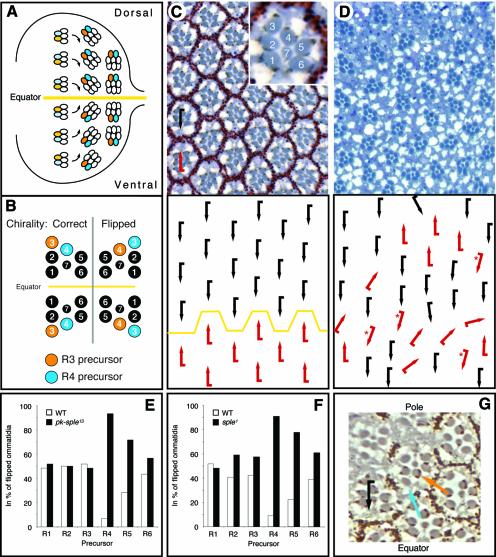Fig. 1. pk is required in the R4 precursor cell. Anterior is left and dorsal is up. Schematic representation of ommatidial patterning in (A) third instar eye disk and (B) adult eye. Clusters rotate in opposing directions with respect to the equator (yellow line) in the eye disk (A) and acquire a dorsal or ventral chirality, as apparent in adult ommatidia (B). R3 precursors are in orange and R4 precursors in blue in both panels. In wild type, the equatorial R3 precursor becomes the anterior tip cell of the cluster, while the polar R4 precursor becomes the posterior recessed cell. Note that in the case of a chirality switch [flipped ommatidia in (B)], the R4 precursor (blue) becomes the R3 cell at the tip of the ommatidium (orange). Tangential sections of adult eyes with a schematic representation underneath are shown in (C) and (D). The insert in (C) shows an enlarged single ommatidium with numbered photoreceptors. (C) Wild-type eye with dorsal (black) and ventral (red arrows) chiral forms separated by equator (yellow line). (D) In pknull (pkpk–sple13), chirality is random (45 ± 3%:53 ± 1%;) and no equator is visible. Thirteen percent of all ommatidia also show rotation defects. Clonal analysis of (E) pknull and (F) pksple1 shows that wild-type R4 precursor cells are highly under-represented in ommatidia with wrong chirality: 267 mosaic ommatidia for pknull (54 of which had the wrong chirality) and 416 mosaic ommatidia for pksple1 (60 of which were flipped) were scored. Statistical analysis showed that the apparent under-representation of wild-type R5 precursors is not significant and is due to its proximity to R4 (see text). Thus pk activity is required only in R4. (G) The PkSple isoform present in the R4 precursor only is sufficient for correct choice of chirality. All R3/R4 mosaic ommatidia with the PkSple-expressing construct (marked autonomously by pigment granules) in R4 were wild type. In contrast, those with flipped chirality had PkSple present in the R3 precursor (orange arrow) but not in the R4 precursor (blue arrow; because of the cell fate switch, the R4 precursor becomes R3 and takes the tip position of the ommatidium). The black arrow shows a rescued ommatidium with correct dorsal chirality.

An official website of the United States government
Here's how you know
Official websites use .gov
A
.gov website belongs to an official
government organization in the United States.
Secure .gov websites use HTTPS
A lock (
) or https:// means you've safely
connected to the .gov website. Share sensitive
information only on official, secure websites.
